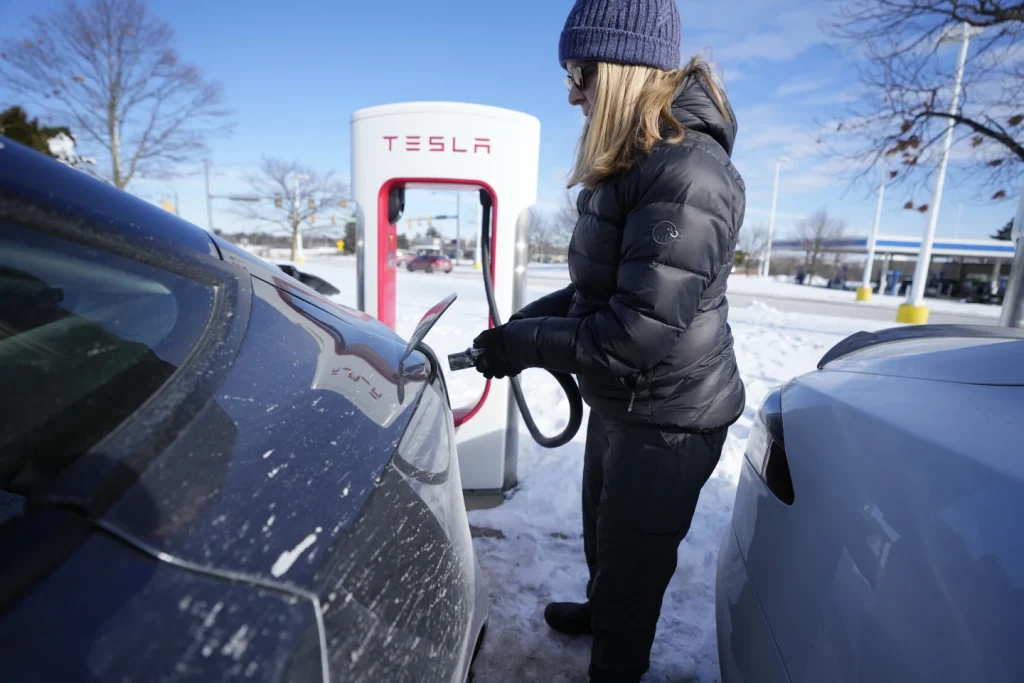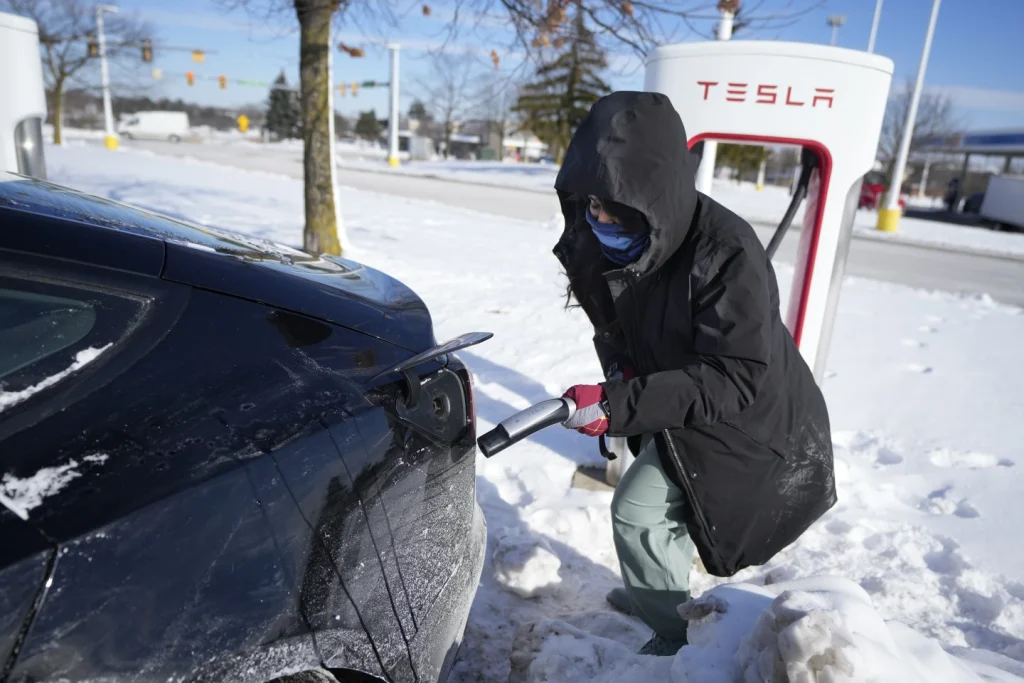The recent spell of frigid temperatures across the United States has brought to light the challenges faced by electric vehicle (EV) owners.
From reduced driving range to prolonged waiting times at charging stations, the extreme cold has underscored the limitations of EVs in subzero conditions.
This essay aims to delve into the effects of frigid temperatures on EV performance, the implications for EV owners, and the potential solutions to mitigate these challenges
The impact of frigid temperatures on EVs is multifaceted. One of the most significant consequences is the reduction in driving range.
As highlighted in the case of Oak Brook, Illinois, and Ann Arbor, Michigan, EVs experienced diminished travel range, leading to long queues at charging stations and instances of vehicles running out of power.
Studies have shown that EVs can lose anywhere from 10% to 36% of their travel range in subzero temperatures, significantly affecting their usability in cold climates.
Furthermore, the cold weather also hampers the charging capabilities of EVs. In extreme cold, EVs may not charge as quickly, and in some cases, owners have reported their vehicles being unable to charge at all.
This exacerbates the challenges faced by EV owners, particularly in regions where frigid temperatures are a regular occurrence.
The implications of frigid temperatures on EVs extend to their owners, who are confronted with the practical limitations of their vehicles in cold weather.
Long wait times at charging stations, reduced driving range, and the risk of running out of power pose significant inconveniences for EV owners, impacting their daily routines and travel plans.
Additionally, the need for meticulous planning and adjustments to accommodate the limitations of EVs in cold weather adds complexity to the ownership experience.
While the challenges posed by frigid temperatures on EVs are evident, there are potential solutions and mitigation strategies that can help alleviate these issues.
Firstly, advancements in battery technology and thermal management systems can enhance the cold-weather performance of EVs, mitigating the impact on driving range and charging capabilities.
Additionally, the expansion of fast-charging infrastructure and the development of cold-weather charging solutions can address the long wait times and charging difficulties experienced by EV owners in extreme cold.

Furthermore, raising awareness among EV owners about the effects of frigid temperatures and providing guidance on cold-weather driving and charging practices can empower them to navigate these challenges more effectively.
Educating consumers about the need for proactive planning and adjustments during cold weather can help minimize the disruptions caused by reduced driving range and charging inefficiencies.
In conclusion, the recent wave of frigid temperatures has shed light on the challenges faced by EV owners, particularly in regions prone to subzero conditions.
The reduction in driving range, prolonged wait times at charging stations, and charging difficulties in extreme cold have underscored the limitations of EVs in such weather conditions.
However, with advancements in technology, infrastructure development, and consumer education, there are opportunities to mitigate these challenges and enhance the cold-weather performance of electric vehicles.
As we continue to witness the growing adoption of EVs, addressing the impact of frigid temperatures on their functionality is crucial for ensuring a seamless and reliable driving experience for owners in all weather conditions.
In conclusion, the recent wave of frigid temperatures has shed light on the challenges faced by EV owners, particularly in regions prone to subzero conditions.
The reduction in driving range, prolonged wait times at charging stations, and charging difficulties in extreme cold have underscored the limitations of EVs in such weather conditions.
However, with advancements in technology, infrastructure development, and consumer education, there are opportunities to mitigate these challenges and enhance the cold-weather performance of electric vehicles.
As we continue to witness the growing adoption of EVs, addressing the impact of frigid temperatures on their functionality is crucial for ensuring a seamless and reliable driving experience for owners in all weather conditions.
Overall, the impact of frigid temperatures on electric vehicles is a multifaceted issue that requires a comprehensive approach involving technological innovation, infrastructure development, and consumer education.
By addressing these challenges, we can pave the way for a more resilient and adaptable electric vehicle ecosystem, capable of thriving in diverse weather conditions and meeting the needs of EV owners across the country.
The problem of slow charging and reduced range in electric vehicle (EV) batteries during cold temperatures is a significant issue that needs to be addressed.
The flow of lithium ions through the liquid electrolyte inside the batteries is hindered by low temperatures, resulting in slower movement of electrons and reduced energy release.
This ultimately affects the range of the vehicle and leads to faster depletion of the battery. Additionally, the slow movement of electrons also hampers the charging process, making it less efficient.
The impact of low temperatures on battery performance is a challenge that has to be overcome, especially in regions with cold climates.
As Neil Dasgupta, an associate professor of mechanical and materials science engineering at the University of Michigan, pointed out, the slowing down of chemical substances in low temperatures is a natural phenomenon that needs to be addressed.
This issue becomes particularly evident at fast-charging stations, such as Tesla’s Supercharger stations, where the batteries need to be even warmer to facilitate efficient charging.
An example of the practical implications of this problem is illustrated by the experience of Ankita Bansal, a Tesla owner who encountered difficulties at a Supercharger station in Pittsfield Township, Michigan.
Despite having only 7% charge left in her battery, the car was unable to accept electricity due to the low temperature.
The battery had to undergo a heating process before it could start charging, resulting in a significant delay.
This situation is not unique to Bansal, as many EV owners face similar challenges, especially those who do not have access to charging stations at home.
In order to address this issue, it is essential for manufacturers and researchers to develop innovative solutions that can mitigate the impact of low temperatures on EV batteries.
This could involve the implementation of advanced heating systems within the batteries to maintain optimal temperature levels, as well as the development of more efficient fast-charging technologies that are less affected by cold weather.
Additionally, the design of EV batteries could be optimized to enhance their performance in diverse environmental conditions.
Furthermore, efforts should be made to educate EV owners about the potential challenges associated with cold temperatures and provide them with guidance on how to manage their vehicles in such conditions.
This could include recommendations for preheating the battery before charging and optimizing driving habits to maximize range during cold weather.
In conclusion, the problem of reduced battery performance in EVs during cold temperatures is a significant obstacle that needs to be addressed through technological innovation and improved user awareness.
By tackling this issue, the EV industry can enhance the reliability and efficiency of electric vehicles, ultimately contributing to the widespread adoption of sustainable transportation solutions.
As the world transitions towards electric vehicles (EVs), it is crucial for drivers to understand the nuances of optimizing their performance, particularly in cold weather conditions.
This essay aims to delve into the insights shared by experts and experienced EV owners to shed light on the necessary steps and future developments that will enhance the functionality of EVs in chilly climates.
Bruce Westlake, the president of the Eastern Michigan Electric Vehicle Association, emphasizes the importance of preconditioning the battery before charging.
He notes that many new EV owners are unaware of this crucial step and suggests that car manufacturers, such as Tesla, should improve their communication regarding such features.
According to Westlake, warming the battery can take up to half an hour in frigid temperatures, but the sacrifice in range is minimal, typically only a few miles.
The experiences of EV owners, such as Bansal and Burney, further underscore the significance of planning ahead, especially in cold weather.
Burney highlights the role of the car in providing information about charging stations and remaining range, emphasizing the need for drivers to become comfortable with their vehicle’s capabilities and charging requirements.
Looking towards the future, experts like Dasgupta anticipate advancements in battery technology and the development of new chemistries that are more resilient in cold weather.
Automakers are expected to tailor EV models to better suit colder climates, potentially sacrificing some overall range to enhance cold-weather performance.

Additionally, significant investments in new battery technology are underway, with the potential to revolutionize EV performance in cold-weather conditions.
In conclusion, the experiences and insights shared by EV experts and owners highlight the necessity for proactive measures in optimizing EV performance in cold weather.
As the industry progresses, advancements in battery technology and tailored EV models are expected to alleviate the challenges associated with cold-weather driving.
With a positive outlook, it is evident that the future holds promising developments that will enhance the experience of EV drivers in cold-weather climates.
